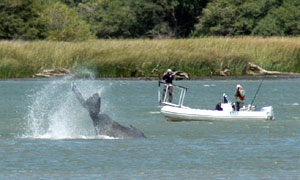 Humpback in Sacramento River. Image source:
Humpback in Sacramento River. Image source:
U.S. Coast GuardFor the past 12 days, residents of the Bay Area have been following the day-to-day saga of two humpback whales (Megaptera novaeangliae) swimming far up to Sacramento River delta. Of course, we don't expect fully ocean-going, marine mammals to wander this far up a freshwater river system, and there's no good explanation for why these whales swam up to Sacramento in the first place. If you've been following the news, officials have adopted a new tactic in this "rescue," which entails banging metal pipes below water with the idea that it'll make the whales feel like they've been locked in a room full of jackhammers with no ear plugs.
Sounds matter to whales because hearing is a primary sense underwater. The marvelously sophisticated biosonar system used by toothed whales (like bottlenose dolphins and orcas) has been well known for almost 50 years. Baleen whales are much more of an enigma: we know that some, like humpbacks, emit low frequency sounds for long periods of time-- whalesong-- but we don't know how they do it, nor do we understand how they hear it. Low-frequency sound travels far underwater, and humpbacks in particular seem to be selective about the depth at which they sing, suggesting that humpbacks use unique differences in the density of ocean water at certain depths that provide communication conduits-- much like the tin can and string telephones that kids use – allowing humpbacks in California to talk with those in Hawaii. Given the long-range migrations that humpbacks undertake, communication across ocean basins isn't such a funny idea, and the evidence to support this idea continues to accumulate.
Manipulating the acoustic environment in the Sacramento River may help the two humpbacks make it back to sea, but, in general, human impacts on the acoustic environment of the oceans has made it a much harder place for whales to communicate. As ambient levels of sound increase with more shipping vessels, the louder whales need to sing to communicate over the din. Not all forms of pollution are material, and the more we learn about the oceans-- using all of our senses – the more we discover that there's so much more to learn.
![]() Nick Pyenson is a PhD candidate at the University of California, Berkeley, in the department of integrative biology and the museum of paleontology.
Nick Pyenson is a PhD candidate at the University of California, Berkeley, in the department of integrative biology and the museum of paleontology.
